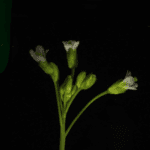A new protocol has been developed that will make breeding novel cannabis cultivars much easier. The process, described in a recent paper from the Canadian Journal of Plant Science, involves directly culturing new plants from floral tissue—a cost-effective shortcut to typical cultivation methods.
With the recent legalization of recreational cannabis use in Canada, the crop has suddenly become big business. Along with this has come an increased need for efficient propagation methods.
Cannabis sativa is dioecious (plants are either male or female) and therefore cannot self-pollinate, which leads to high variability of traits when the plants are grown from seed. To maintain uniformity of these traits, the crop is usually propagated asexually from stem cuttings.
To accomplish this, some cultivars can be prevented from flowering and maintained in a vegetative state by artificially adjusting their lighting conditions to mimic long days. But many important traits, such as a new cultivar’s chemical profile, only become apparent during the reproductive phase. This means that breeders must take cuttings before the plant flowers, maintain them in a vegetative state, then come back to select them once the parent plant has flowered and been evaluated. The practice is inefficient and means each plant must be maintained in two locations, costing time and money.
The new technique aims to solve this problem by allowing the propagation of floral tissue from the parent plant. The authors tested floral tissues of three cultivars in the early flowering stage and one cultivar in the late flowering stage, treating them with different concentrations of Thidiazuron, a chemical commonly used on difficult-to-propagate species.
Both the mature tissue and two of the three immature tissue cultivars successfully formed shoots that then rooted and grew into normal, healthy plants. This paper is the first to present a method of propagating C. sativa in the flowering stage and will allow breeders to propagate the plant right up to harvest time.
Co-author Max Jones, an associate professor at the University of Guelph, notes that the new method will benefit breeders more so than the average grower. “This protocol will allow producers to propagate plants that have already gone to flower,” he said. “While this will not replace standard propagation systems, it will be helpful in breeding programs, or to propagate interesting plants that have already started to flower.”
The method will also be useful for those cultivars that are day neutral, meaning they cannot be held in a pre-flowering stage by manipulating their lighting conditions. “For propagation, day neutral cultivars present a challenge since they cannot be maintained as mother plants to produce cuttings,” said Jones. “The protocol we developed could be used to maintain these genotypes and propagate them for use in these applications.”
Jones explained that research on cannabis production is still in the process of catching up with other crops. “Due to the decades of prohibition, many technologies such as plant tissue culture and micropropagation are underdeveloped in cannabis,” he said. “Many of the basic requirements for the species have not been fully worked out, so we are currently going back to basics—what is the optimal nutrient mixture, light levels, etc.—before we move forward with more advanced projects.”
Read the full study: Regeneration of shoots from immature and mature inflorescences of Cannabis sativa in the Canadian Journal of Plant Science.




